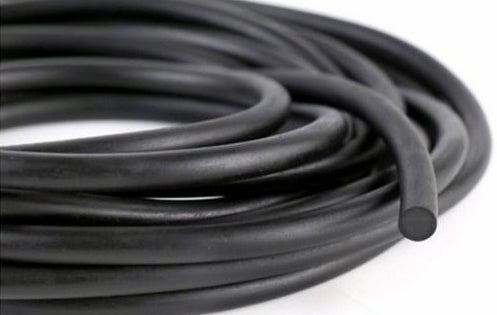Extruded Round Gasket Cord, 5.5mm (.2187") Diameter x 100ft
Product Features
- Extruded Round Cord / EPDM
- Firm Density
- .2187" ; 7/32" Diameter x 100 Ft length
- No Adhesive
Grid Gasketing
Every CNC Router that is employing vacuum hold-down methods needs to incorporate some type of gasketing material.
This gasketing material is essential to fill the void between the router table and the spoilboard, creating a quality vacuum clamp on the spoilboards to maximize vacuum performance. Too narrow and it will slip in the channel. Too wide and it will pinch when trying to zero out on the z-depth. The ideal product will completely fill the channel width-wise evenly and stick above the surface of the channel by roughly 1/16” and match the channel shape.
Gasketing Guide:
- Rounded channels and dove-tail channels use rounded gasket products. Square channels use square gasket products.
- The gasketing should stick proud above the table by 1/16″.
- Non-adhesive material is best. When it comes time to replace the gasketing there is not adhesive residue left behind in the channels.
- The gasket width is often intended to be a bit larger than the actual channel to leave some materials above the channel depth. The round cord gasket tends to stretch or pull while fitting an oval shape to have it fit securely and create a good seal around the perimeter of the table.
- For round gasketing, create a “butt” joint at the end and make sure not to stretch the gasket when inserting.
- Replace the gasketing in your table like you would replace the oil in your car. If the gasketing wears and becomes flush with the table, it is time to replace it.
- Understanding your spoilboard density is crucial. We typically recommend 45 lbs. of MDF for a good starting point with the right balance of vacuum suction and flow depending on your CNC’s specifications.
- Many man-made woods have various differences between different suppliers, even if the material is listed as the same. A common example of this is plywood that can have varying glue compositions and density at each layer caused from several available methods of production.
Seal the spoil board edge – Sealing the edge of the spoil board prevents vacuum loss. The goal is to close the pores to prevent vacuum loss. Seal edges BEFORE surfacing board.
Note: Edge banding is NOT recommended. It has a tendency give way and not to cut clean when fly cutting, which will keep the outside parts from holding flat and also result in loss of vacuum.
Machine spoil board – “Fly cut”, “dress”, “surface” all names given to machining the spoil board to increase the flow characteristics (porosity) by removing the hard compressed surface (glues) created when the board was heated and pressed during the manufacturing process.
- Machine both sides approximately .020 - .040” (.5 – 1mm) or until board has consistent flat color and no longer has shiny glue areas remaining sealed.
- Feed speed for fly cut should be at least 1200ipm (30m/min) which should create a very light fuzzed surface which is desirable for part holding.
- Spoil board can be machined once per day to once per month depending on specific applications. Once per week seems to be the norm. Averages are approximately every 30-50 sheets, depending on patterns being cut.
Note: Cutting too slow will create heat and will reseal the surface.
Through cuts in spoil board – Only program the through cutters to penetrate through the substrate .003 - .005” (.1mm)
Note: Cutting too deep will create channels and vacuum will be lost.
Other things to check if parts are moving:
Software – Is the software taking into consideration?
- Part size – Cut small parts first, apply cutting rules based on size.
- Lead in/lead out’s on sheet side to keep part’s attached as long as possible.
- “Onion skinning” and “tabbing” based on part size.
Tooling
- Is the proper feed speed being applied based on recommended chip load?
- Is the tool sharp?
- Consider using a smaller diameter tool (3/8”) to reduce side load on small parts.
Vacuum pump – remember, high elevations effect pump performance
- Is regular maintenance being done? – filters needing to be cleaned is the most common issue.
- Is there a vacuum leak in the plumbing somewhere?
- Is the vacuum pump performing to its specification?


